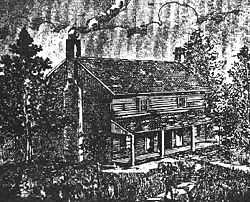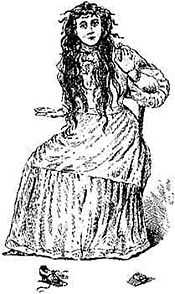Bell Witch

The Bell Witch or Bell Witch Haunting is a poltergeist legend from Southern folklore, centered on the 19th-century Bell family of Adams, Tennessee.
Basic legend

John Bell Sr., who made his living as a farmer, resided with his family in Adams, Tennessee in the early 1800s. In 1817, his family came under attack by a witch, who was believed to be a lady called Kate Batts.[1] Various accounts written afterward, tell stories similar to other poltergeist legends. It began with noises in the walls and grew to include unusual sounds, people being slapped and pinched, objects being thrown, and animals being spooked without visible cause.
In the 1894 book An Authenticated History of the Bell Witch, author Martin Van Buren Ingram claims that the poltergeist's name was Kate, and that she frequently cursed the Bell family out loud. The activity centered on the Bells' youngest daughter, Betsy, and worsened after she became engaged to one Joshua Gardner.[2]
Several accounts report that during his military career, Andrew Jackson was intrigued with the story and was frightened away after traveling to investigate.[3] Other stories relate that the family was haunted by scratching noises outside their door after Bell found a half-dog, half-rabbit creature. Some stories end up with Bell being poisoned by the witch.[4] Accounts vary about the witch being someone who had been cheated by Bell or a male slave whom Bell had killed.[5][6]
Goodspeed's History of Tennessee
The only known account of the haunting prior to Ingram's publication was in 1886, more than 60 years after the events. This one paragraph in the Goodspeed Brothers book History of Tennessee does not mention Andrew Jackson or the death of Bell Sr.:
A remarkable occurrence, which attracted wide-spread interest, was connected with the family of John Bell, who settled near what is now Adams Station about 1804. So great was the excitement that people came from hundreds of miles around to witness the manifestations of what was popularly known as the "Bell Witch." This witch was supposed to be some spiritual being having the voice and attributes of a woman. It was invisible to the eye, yet it would hold conversation and even shake hands with certain individuals. The feats it performed were wonderful and seemingly designed to annoy the family. It would take the sugar from the bowls, spill the milk, take the quilts from the beds, slap and pinch the children, and then laugh at the discomfort of its victims. At first it was supposed to be a good spirit, but its subsequent acts, together with the curses with which it supplemented its remarks, proved the contrary.[7]
Paranormal investigator Benjamin Radford, as well as Brian Dunning, conclude that there is no evidence that Andrew Jackson visited the Bell family home. During the years in question, Jackson's movements were well documented, and nowhere in history or his writings is there evidence of his knowledge of the Bell family. According to Dunning, "The 1824 Presidential election was notoriously malicious, and it seems hard to believe that his opponent would have overlooked the opportunity to drag him through the mud for having lost a fight to a witch."[8][9]
Martin Van Buren Ingram
All of the above accounts of the legend are drawn from two sources. In part, the Goodspeed article was a source, but newspaper publisher Martin Van Buren Ingram provided most of the material. Seventy-five years after the Bell Witch events, he wrote An Authenticated History of the Bell Witch. Ingram states that he based his book on the diary of Richard Bell, who was a son of John Bell Senior. The events happened when Richard Bell was 6–10 years old, but he didn't write the diary until he was 30. According to Brian Dunning no one has ever seen this diary, and there is no evidence that it ever existed: "Conveniently, every person with firsthand knowledge of the Bell Witch hauntings was already dead when Ingram started his book; in fact, every person with secondhand knowledge was even dead." Dunning also concluded that Ingram was guilty of falsifying another statement, that the Saturday Evening Post had published a story in 1849 accusing the Bells' daughter Elizabeth of creating the witch. That article does not exist either.[8]
Evaluation
According to Radford, the Bell Witch story is an important one for all paranormal researchers: "It shows how easily legend and myth can be mistaken for fact and real events and how easily the lines are blurred" when sources are not checked.[9] Dunning wrote that there was no need to discuss the supposed paranormal activity until there was evidence that the story was true. "Vague stories that there was a witch in the area. All the significant facts of the story have been falsified, the others come from a source of dubious credibility. Since no reliable documentation of any actual events exists, there is nothing worth looking into."[8]
Dunning concludes, "I chalk up the Bell Witch as nothing more than one of many unsubstantiated folk legends, vastly embellished and popularized by an opportunistic author of historical fiction."[8] Radford reminds readers that "the burden of proof is not on skeptics to disprove anything but rather for the proponents to prove... claims".[9]
Joe Nickell has written that many of those who knew Betsy suspected her of fraud and the Bell Witch story "sounds suspiciously like an example of “the poltergeist-faking syndrome” in which someone, typically a child, causes the mischief."[10]
Bell Witch today
There have been several movies based, at least in part, on the Bell Witch legend, including The Blair Witch Project in 1999, Bell Witch Haunting in 2004, An American Haunting in 2005, and Bell Witch: The Movie in 2007.
The Danish metal band Mercyful Fate have a song titled "The Bell Witch" on their 1993 album In the Shadows.[11]
Seattle-based doom metal band Bell Witch took their name from this legend.
See also
Notes
- ↑ http://www.bellwitch.org/story.htm
- ↑ Hendrix, Grady, "Little Ghost on the Prairie; An American Haunting is definitely not based on a true story", Slate Magazine, May 4, 2006.
- ↑ McCormick, James; Macy Wyatt (2009). Ghosts of the Bluegrass. University Press of Kentucky. p. 94.
- ↑ http://www.bellwitch.org/biographies/johnbell.htm#ftn2
- ↑ Hudson, Arthur Palmer; Pete Kyle McCarter (January–March 1934). The Bell Witch of Tennessee and Mississippi: A folk legend. The Journal of American Forklore. pp. 45–63.
- ↑ Monaham, Brent (2000). The Bell Witch: An American Haunting. St. Martin's Griffin.
- ↑ Godspeed Brothers (1886). History of Tennessee. Godspeed Publishing Co.
- ↑ 8.0 8.1 8.2 8.3 Dunning, Brian. "Demystifying the Bell Witch". Skeptoid. Retrieved 2012-10-28.
- ↑ 9.0 9.1 9.2 Radford, Benjamin (January–February 2012). "The Bell Witch Mystery". Skeptical Inquirer Magazine 36 (1): 32–33.
- ↑ Nickell, Joe. (2014). "The ‘Bell Witch’ Poltergeist". Csicop.org. Retrieved 2014-07-12.
- ↑ "Mercyful Fate - In the Shadows". Encyclopaedia Metallum.
External links
| Wikimedia Commons has media related to Bell Witch. |
- MonsterTalk episode on The Bell Witch
- The Bell Witch by researcher Pat Fitzhugh.
- The Historic Bell Witch Cave
- The Bell Witch of Tennessee - website which includes the full text of An Authenticated History of the Famous Bell Witch - the book upon which the legend is largely based.
- Prairie Ghosts - The Bell Witch
- The Spirit of Red River, by Jack Cook, a viral blog-spot designed to reinforce the legend, supposedly compiled from official government, church, and family records.